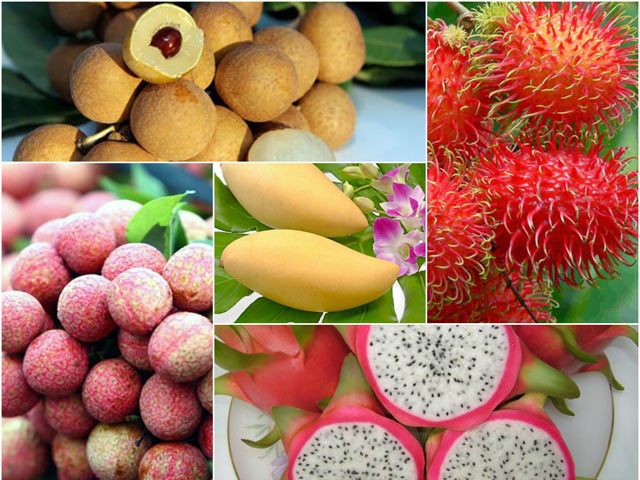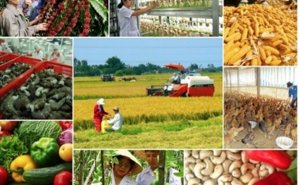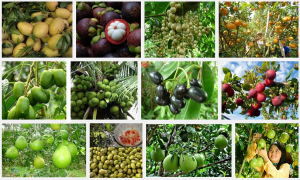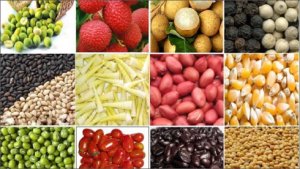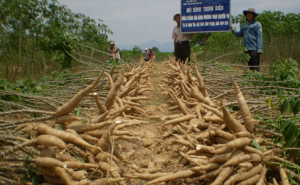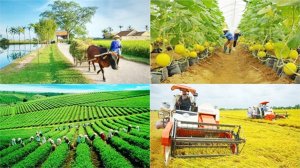|
2015 AGRICULTURE AND FURTHER WORK LOOKING
Tuesday, 2016/01/19 | 14:49:30
|
|
Prof. Bui Chi Buu
Despite the economic slump that is affecting other emerging economies in the region, the Vietnamese economy is expected to outperform its regional peers both this year and in the next few. The GDP growth for 2015 is expected to be 6.68% (the highest since 2007). The GDP expanded 7 percent in the fourth quarter of 2015 over the same quarter of the previous year
In recent years, the nation has been rising as a leading agricultural exporter and an attractive foreign investment destination. Vietnam's key products are rice, cashew nuts, black pepper, coffee, tea, fishery products and wooden products. However, TPP will bring pressure in agricultural competitiveness, such as in milk products. It will promote the market economy but high standards in administrative management will create challenges for state management. The Food and Agriculture Organization has been nominated to implement the International Year of Soils 2015 (IYS 2015), within the framework of the Global Soil Partnership and in collaboration with Governments and the secretariat of the United Nations Convention to Combat Desertification. The IYS 2015 aims to increase awareness and understanding of the importance of soil for food security and essential ecosystem functions.
In 2015 COP21, also known as the 2015 Paris Climate Conference, aimed to achieve a legally binding and universal agreement on climate, with the aim of keeping global warming below 2°C. Global warming is projected to have significant impacts on conditions affecting agriculture, including temperature, carbon dioxide, glacial run-off, precipitation and the interaction of these elements.
IAS worked with our partners to keep the spotlight pinned on this critical situation in the drought prone areas of Central Vietnam. The region expanded 157,000 ha due to El Nino influence. This addressed 36,000 ha where agricultural production had to be over due to heavy drought in the dry season, with 5,000 ha fully lost.
In 2015, the total export turnover of agro-forestry and fisheries exceeded the sector's annual target, hitting US$ 30.14 billion, down 0.8% as compared to 2014. The agricultural GDB value increased 2.41 % (based on 2010 standard) including the increment of agriculture, sylviculture and fishery of 2.28%, 8.92% and 3.06%, respectively. New figures were recorded as forest cover percentage of 40.73%, and 1,478 communes met the demand of new rural development standards.
Rice growing areas developed 7.83 million ha (18,600 ha increased) with rice production of 45.2 million T (241,000 t increased) and average yield of 5.77 t/ha. The milled rice export of 6.24 MT obtained the turnover value of $ 2.65 billion (4.9% decreased) in 2014.
Maize growing area is 1.179 million ha (300 ha increased) with average yield of 4.48 t/ha. Total maize production gained 5.28 million T (1.5% increased). Maize growing area will develop 1.22 million ha in coming year with the productivity of 4.50 t/ha and total production of 5.5 million ton.
Cassava growing area is 566,000 ha (13,700 ha increased) and obtained 10.67 million T with cassava productivity of 18.84 t/ha (0.37 t/ha increased). The export turnover of cassava products offered a new record of over $US 1.5 billion.
Fruit orchards developed 843,700 ha with production of 930,000 T. The export turnover of fruit and vegetable offered more than $ 1.85 billion (another figure of more than $ 2 billion).
Sweet potato growing area is 130,000 ha and obtained 1.41 million T (1,000 t increased), in particular Vinh Long province production and areas.
Vegetable areas increased up to 0.89 million ha (9,000 ha increased) with the production of 15.66 million T (20,000 t increased) and productivity of 17.6 t/ha (1% increased).
Pulse crops obtained 175,000 ha (15,000 ha increased), with the production of 183,700 t (11% increased).
Soybean growing area is 96,000 ha (14,000 ha decreased) with the production of 133,000 ton (24,000 t decreased) and productivity of 1.39 t/ha (0.05 t/ha decreased).
Groundnut growing area covered 190,000 ha (8,000 ha decreased) with the production of 399,000 ton (55,000 ton decreased) and the average yield of 2.10 t/ha (0.075 t/ha decreased). In particular, Tayninh groundnut growing areas from 30,000 ha previously downed to 6,000 ha today. Very high labor cost made Tayninh farmers change their groundnut into others. Mechanization is quite imperative.
Sugarcane developed 195,000 ha (10,000 ha decreased) with the production of 20 million tonnes and average yield of 64.5 t/ha.
Rubber area is 970,000 ha including 530,000 ha for production of 985,000 ton of latex (12,000 t increased). The average yield offered 1.72 t/ha. The export turnover of rubber offered $US 1.37 billion (14.84% decreased).
Cashew nut cultivated area is slightly reduced 300,000 ha (3,000 ha decreased) with the productivity of 1.32 t/ha (10% increased) and the production of 400,000 ton (15.94% increased). The export turnover of cashew nut products offered a new record of over $US 2.2 billion.
Black pepper is welcome to its promotion of over 85,000 ha including 50,000 ha for production with good price in the market. Pepper production obtained 165,000 and the average yield gained 2.58 t/ha. The export turnover of black pepper offered $US 1.2 billion with 124,000 t
Coffee growing areas is 640,000 ha with the average yield of 2.21 t/ha and the production of 1.42 million T. Coffee replanting areas offered 11,500 ha. The export turnover of coffee offered a new record of $US 2.6 billion (13% decreased) with 1.2 million tonnes (20% decreased).
Tea growing area is 132,000 ha (5.4% increased) with the production of 1 million ton (6.7% increased) and the average yield of 8.45 t/ha (fresh young leaves).
Coconut cultivated area is 145,000 ha including 128,000 ha for production with the average yield of 9.45 t/ha and the production of 1.21 MT.
Total meat production obtained 4.782 million T with 2.6 m, 5.6 m, 0.27 m, 28.2 and 324.2 m of buffalo, cow, dairy cow, pig and poultry, respectively. Animal feedstuff production was estimated to get up to 16.7 million T.
Product value per ha obtained VND 82-83 million/ha in 2015 ($ 3,950/ha) overall. Fishery offered VND 183 million/ha ($ 8,710/ha) particularly.
The export turnover of agro-products, aqua-products and wood products offered $ 13.9 (2.8% decreased), $ 6.53 (16.5% decreased) and $ 7.10 billion (8.2% increased); respectively.
The Government has approved a plan to set up high-tech agricultural zones and areas around the country that aims to have 10 such zones by 2020. By 2030, the country will set up at least 10 more high-tech agricultural zones. Developers of high-tech agricultural zones and investors in the zones will be offered various incentives. Viet Nam has 14 million hectares of forest, which are home to 3,000 animal and plant species, excluding wood. In addition, trading of non-timber forest products had not been carried out with contracts, so the business remained uncertain.
In 2015, Viet Nam exported 3 million tonnes of lychees and 100 tonnes of longans to the US. This was the first time that Vietnamese lychees and longans were exported to this market.
Foremost among Vietnam's agricultural troubles was exceptionally adverse weather, including a drought in 2015. Accordingly, it will be more serious in coming year due to El Nino influence. Various challenges were addressed from the start to strengthen and inform work by the IAS how to improve the situation next year, how to mitigate the impacts of climate change, how to align research objectives with farmers’ needs and to analyze the yield gaps for the major crops in Southern Vietnam particularly tuber crops and maize.
The IAS must directly face to TPP influence on agricultural products in Southern Vietnam. The proposed Trans-Pacific Partnership (TPP) is Vietnam’s next step toward increased economic integration. Vietnam’s current preferential trade agreements (PTAs) with many of the negotiating TPP countries already provide low or duty-free rates. Major Vietnamese exports, such as coffee and natural rubber, are not expected to gain from an agreement. TPP could provide new opportunities where those agreements did not liberalize market access. Rice and smaller export sectors (cassava starch, pepper, processed foods, and honey) could grow. Additional economic growth generated by an agreement would also increase Vietnam's import demand. Vietnam is expected to have market potential for imported food and agricultural products. Vietnam’s participation in the proposed TPP is intended to continue its path toward further economic integration and growth.
The IAS scientists must engage in dynamic partnerships around various common priorities, projects and cross-crop issues during the research programs by MARD and international projects, which included participants from an array of Vietnam Academy of Agricultural Science (VAAS)’ institutions and other organizations. The IAS would significantly boost its research impacts by making its work more effective to become a positive member of VAAS in coming year. |
|
|
|
[ Other News ]___________________________________________________
|


 Curently online :
Curently online :
 Total visitors :
Total visitors :
